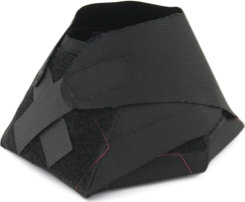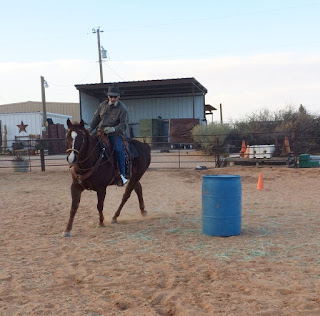Riding your horse in a good circle, not necessarily a perfect circle, but a circle where your horse's foot
falls are reasonably on top of each other is pretty hard to do for most riders and so it is always a good
exercise to work on. Carol thinks so so she wrote to me asking: "I am having troubles doing a circle on my
horse as she always wants to cut the circle so it becomes a curly cue. Any suggestions would be appreciated."
Circles is a tough thing for me to do well too, Carol. The first thing I'd look at is my riding posture. I
have a tendency to slump rather than ride upright with a straight back,...in fact, I've been told I look like
a hung over monkey when riding. But leaning, especially when doing circles or making turns is a more common
issue.
In may appear in the photo at right that I am leaning inside the circle, but if you draw a straight line from the horse's back, up the center of the cantle it should go through my head. I am looking forward where I want to ride to and through.
It is easy to lean inwards towards the inside of the circle when riding circles. A horse will
compensate when the rider is leaning. And although it would seem that leaning inside of the circle will push
your horse to the outside, sometimes a horse will compensate by trying to move under the weight.
Just make
sure that you are upright and centered over the saddle. It may help to have someone watch you or even video
you so you can eliminate posture or balance as a problem.
It may help to use a ground aid such as traffic cones to mark a circle. A couple other ways to mark a ground
circe would be to mark a circle in flour or even use a stake with a string tied to it and a stick on the
other end to mark a circle on the ground. Any method will give you a ground reference on maintaining a
circle.
In the photos for this article, I am using a barrel in the center of my circle. The problem you may
find using just a marker for the center of your circle, such as my barrel, is that you may tend to look
inwards toward it and inadvertently give your horse a cue to cut the circle towards the center as looking
inward will shift your hips, even slightly, and your horse can feel that change in your seat.
When I ride circles I try to tip my horse's head to the inside of the circle just enough so I can see the tip
of his inside eye. My inside rein is slightly higher than my outside rein. On the photo at left you can see my horse's head just tipped inside slightly so I can see the tip of his inside eye from my position in the saddle.
My outside rein is a supporting
rein to keep my horse's head from tipping too far inside, but it is common for a rider to have the outside rein
too tight so it retards the horse's momentum, or just tight enough so that when the horse's head dips with
his stride he gets intermittent bump in the mouth through the bit and may raise his head - I'd watch for
these things as well.
I use my outside leg to give and maintain my horse's forward momentum while my inside leg is basically in
neutral. A way to think about it is that your are trying to ride your horse around your inside leg getting a
slight bend.
You would use more pressure on your inside leg if your horse's starts to cut the circle. Just
like you would use pressure with your left leg to ask your horse to make a side pass to the right.
At the photo (right) you can see my horse's inside rear foot (his left rear) stepping inside and forward of the right rear. This is because we are cutting the circle - the problem you describe - and I am using inside leg pressure to push him back outside onto the circle. It may also help to slightly bend his head inside so that maybe you are seeing the entire inside eye rather than just the tip of it.
One thing you can do to work on controlling your horse's barrel or otherwise getting some lateral movement
during forward momentum is to ride your circles and intentionally expand them using inside leg pressure.
Riding alongside a fence, like in the arena, and practicing small and larger circles ending back on the fence where you began is a good way to judge how decent your circles are, absent of having a ground circle to ride around. And finally, just make sure your horse isn't cutting the circle because it's the most direct route back to his pen. Good luck and safe journey.




















I surprise how much effort you put to create such a great informative website. Visit: Horse Arena
ReplyDelete